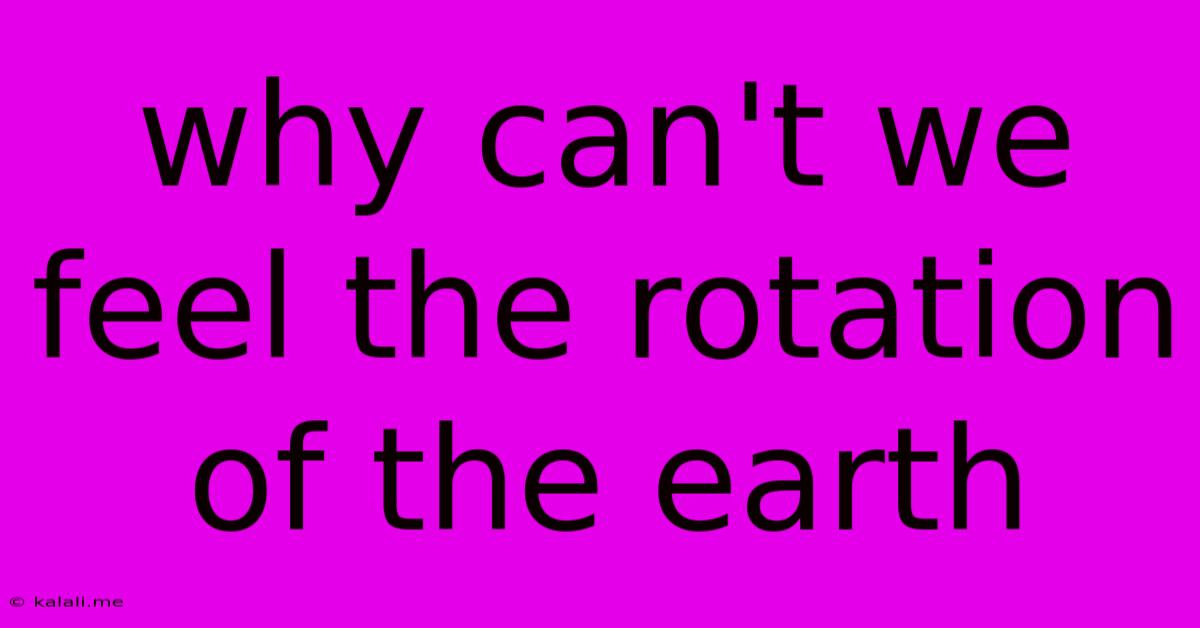Why Can't We Feel The Rotation Of The Earth
Kalali
Jun 08, 2025 · 3 min read

Table of Contents
Why Can't We Feel the Earth's Rotation? A Journey into Physics and Perception
We live on a planet spinning at approximately 1,000 miles per hour (1,600 km/h) at the equator. That's incredibly fast! Yet, we don't feel a thing. Why? This seemingly paradoxical situation is a testament to the consistent and pervasive nature of Earth's rotation, coupled with our own perception and the laws of physics. This article explores the reasons behind this fascinating phenomenon.
The simple answer lies in inertia and the concept of a non-inertial frame of reference. Let's break it down:
Inertia: The Constant State of Motion
Newton's First Law of Motion explains inertia perfectly: an object in motion tends to stay in motion with the same velocity unless acted upon by an external force. We, along with the atmosphere, the oceans, and everything else on Earth, are all moving at the same speed as the planet's rotation. Think of it like being in a car traveling at a constant speed on a smooth highway – you don't feel the speed unless there's acceleration or deceleration. The Earth's rotation is remarkably constant, providing a smooth, consistent ride.
Frames of Reference: It's All Relative
Our perception of motion is relative to our frame of reference. We are firmly planted within the Earth's rotating frame of reference. Everything around us—the air we breathe, the buildings we see—is rotating along with us at the same speed. There's no relative motion to detect. To feel the rotation, we'd need a contrasting, non-rotating frame of reference. Imagine trying to feel the Earth’s spin while inside a completely sealed and smoothly-rotating spaceship; you wouldn’t feel the rotation within the spaceship because everything is moving uniformly.
The Magnitude of Earth's Rotation and Scale
While the Earth's rotational speed is considerable, the radius of the Earth is also enormous. This large radius means the angular velocity – how quickly the Earth turns relative to its size – is relatively slow. This slow angular velocity is another factor why we don't perceive the rotation directly.
The Coriolis Effect: An Indirect Consequence of Rotation
While we don't feel the Earth's rotation directly, its effects are observable. The Coriolis effect is a consequence of Earth's rotation and influences the movement of large-scale systems like wind patterns and ocean currents. It causes moving objects to curve to the right in the Northern Hemisphere and to the left in the Southern Hemisphere. This isn't a sensation we feel directly, but a demonstrable effect of the Earth's spin on large-scale systems. Consider the rotation of hurricanes or the deflection of long-range projectiles – these are tangible effects of the Earth's rotation.
Why We Can Notice Other Motions
We can easily feel the acceleration and deceleration of vehicles or the vibrations of a moving train because these involve a change in velocity – a departure from inertia. Earth's rotation, on the other hand, is remarkably uniform, lacking these noticeable changes in velocity.
In conclusion, our inability to feel the Earth's rotation is a combination of inertia, our relative frame of reference, the scale of the Earth, and the remarkably constant nature of its rotation. While we may not perceive it directly, the Earth's rotation is a fundamental force shaping our world and influencing many observable phenomena.
Latest Posts
Latest Posts
-
How Can I Test An Ignition Coil
Jun 08, 2025
-
Why Do Fire Alarms Go Off At Night
Jun 08, 2025
-
How To Test A Car Fuse
Jun 08, 2025
-
How To Calculate Current In A Series Circuit
Jun 08, 2025
-
What Makes One Protein Different Or Unique From Other
Jun 08, 2025
Related Post
Thank you for visiting our website which covers about Why Can't We Feel The Rotation Of The Earth . We hope the information provided has been useful to you. Feel free to contact us if you have any questions or need further assistance. See you next time and don't miss to bookmark.